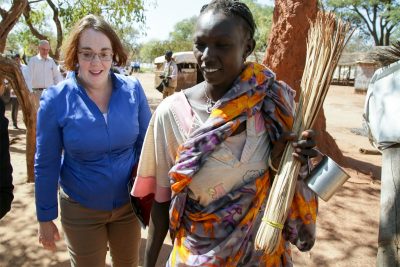By
Peter Louis
The UN Refugee Agency yesterday organised a one-day field trip to Ajuong Thok refugee camp, Unity State, for the US Ambassador to South Sudan, Molly Phee.
This came as a response to the Ambassador’s request to gain first-hand information about the situation of Sudanese refugees fleeing South Kordofan, to appraise the impact of the US aid contribution on refugees’ living conditions and to show solidarity with the refugees.
Canadian Ambassador Nicholas Coghlan, South Sudan’s Commissioner for Refugee Affairs Bol John Akot and UNHCR Representative in South Sudan Ahmed Warsame accompanied Ambassador Phee along with other donor representatives from the European Commission’s Humanitarian Aid and Civil Protection Office (ECHO) and the UK’s Department for International Development (DFID).
During her trip, Ambassador Phee paid a visit to the reception centre and met with refugees recently arrived from South Kordofan. “It is heartbreaking hearing the stories of mothers and small children making the perilous journey from across the border in search of safety,” says Phee. “But I am so glad to see that UNHCR and its partners are sparing no efforts to address their needs. I have no doubt that our contribution is making a positive impact on the lives of these refugees.”
UNHCR established Ajuong Thok camp in March 2013 to provide sanctuary to refugees fleeing the conflict between the Sudanese Armed Forces and the Sudan’s People Liberation Movement-North in South Kordofan. In nearly three years, the camp has become a small rural town with services and facilities for the refugees and the host community, including 50 km of in-camp roads, 315 water points, a primary health care centre, three primary schools, a secondary school and a computer lab.
The camp population has more than doubled compared to December 2014 due to ongoing fighting and violence in the war-torn Nuba Mountains. With a current population of nearly 31,000 refugees, the camp is being expanded to accommodate up to 40,000 people. Refugees who have recently arrived in Ajuong Thok have reported that there are many people in South Kordofan awaiting the end of the rainy season to cross into South Sudan.
“As the camp population continues to grow, there will be a need for more shelters, schools, health facilities, water stands and toilets,” says Warsame. “We rely on our donors to help us meet the basic needs of the refugees, especially the most vulnerable individuals.”
UNHCR’s largest donor globally and in South Sudan, the US Government has contributed more than $90 million to UNHCR in 2015 to help protect and assist refugees in Africa’s youngest nation. “Without the support of our donors, it would have been impossible for us to help more than a quarter of a million of refugees who have sought asylum in South Sudan and desperately need life-saving assistance and protection,” says Warsame. “A special thank-you goes to the United States for generously providing 80 per cent of funds received by UNHCR in South Sudan this year.”
Before returning to Juba, the US Ambassador also had the opportunity to meet with the refugee leaders to hear the concerns of their community. Food, access to higher education and health care remain top priorities for the refugees.
South Sudan remains a country of asylum for more than 265,000 refugees. Ninety per cent are from Sudan’s South Kordofan and Blue Niles states and live in camps across the northern states of Unity and Upper Nile. The remaining 10 per cent are refugees from the Democratic Republic of the Congo, the Central African Republic and Ethiopia who live mostly in Central and Western Equatoria. In coordination with the Government of South Sudan and partners, UNHCR assists and protects refugees and is also part of the multi-agency response to internally displaced people, as lead of the Protection Cluster.



No Comments Yet!
You can be first to comment this post!